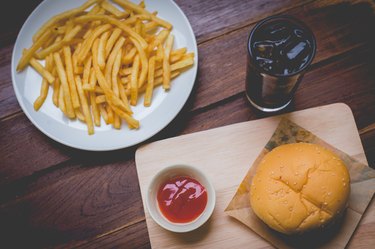
Reading a list of additives on a food label can be bewildering. Not only is the list typically lengthy, but the names are also unfamiliar and confusing. It can feel like you're reading hieroglyphics. Although food additives are generally thought of as harmful, not all added substances are dangerous. Understanding food additive advantages and disadvantages, as well as additive types, helps you make wise food choices.
Food Additive Overview
Video of the Day
Legally speaking, food additive refers to any substance used in the production, processing, treatment, packaging, transportation or storage of food. A substance used for a specific purpose, such as a sweetener, is referred to as a "direct additive" and is typically listed on the food's ingredient label. Indirect food additives, on the other hand, are substances that find their way into foods in small amounts due to packaging, storage or other handling. The U.S. Food and Drug Administration requires that food manufacturers prove a substance's safety before it is permitted to be used in contact with food.
Video of the Day
Food Additive Advantages
Some additives improve or maintain the food's nutritive value. Vitamins A, C, D, E, thiamine, niacin, riboflavin, pyridoxine, folic acid, calcium carbonate, zinc oxide and iron are often added to foods such as flour, bread, biscuits, breakfast cereals, pasta, margarine, milk, iodized salt and gelatin desserts. Instead of vitamin C, you may see ascorbic acid listed. Alpha-tocopherol is another name for vitamin E, and beta carotene is a source of vitamin A. In addition to providing nutrients, food additives can help reduce spoilage, improve the appearance of foods and increase the availability of a variety of foods throughout the year.
Food Additive Disadvantages
Some food additives can potentially cause harmful side effects. For example, butylated hydroxyanisole, commonly known as BHA, is a preservative used in foods including potato chips, crackers, beer, baked goods and cereal. It has been classified by the U.S. Department of Health and Human Services as a preservative "reasonably anticipated to be a human carcinogen." Sulfites, which are added to baked goods, wine, condiments and snack foods, could cause hives, nausea, diarrhea and shortness of breath in some people.
Colors Are Additives, Too
Coloring, in the form of dyes, pigments or other substances, is technically considered a food additive. These substances are often used to enhance color that's lost due to storage or processing. Pigments derived from natural sources, such as vegetables, minerals or animals, are exempt from certification. Man-made colors require testing by both the manufacturer and the FDA to ensure they meet specific guidelines for purity.
- Clinical and Experimental Allergy: Journal of the British Society for Allergy and Clinical Immunology: Clinical Effects of Sulphite Additives
- U.S. Food and Drug Administration: Color Additives: FDA's Regulatory Process and Historical Perspectives
- MedlinePlus: Food Additives
- U.S. Department of Health and Human Services: National Toxicology Program: Report on Carcinogens: Butylated Hydroxyanisole
- U.S. Food and Drug Administration: Overview of Food Ingredients, Additives and Colors